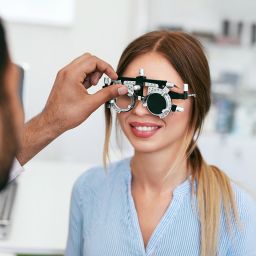Tips For Driving At Night With Astigmatism
People with astigmatism have an uneven cornea. The irregular cornea causes blurred distance and near vision. Astigmatism patients need to take special care and ensure they can see clearly. When driving at night, the cornea refracts light inside your eyes. But because it’s already uneven, the clear front “window” of the eye changes the direction of the light, making everything else look funny and irregular.
Everybody faces challenges while driving at night. However, Astigmatism patients struggle more because the shape of their lens compromises clear vision. Lights meant to be helpful could be hazardous to people with this condition. For Astigmatism drivers, the traffic lights intended to control traffic and reflective street signs meant to guide you may appear distorted and annoying.
In this article, we have explained how Astigmatism affects your vision and provided tips for driving at night with it.
What is Astigmatism?
Astigmatism is a condition in which the cornea of your eye is not round as it should be. The condition affects the normal functioning of the lens and cornea. Usually, the cornea and lens should be round, but astigmatism turns them curved.
The eyes collect light through the cornea and direct the rays to the retina. An image is then produced in the retina. Astigmatism condition means the light collected by the cornea isn’t focused in one place as it should be.
When light is focused on more than one place in the eyes, you could experience the following:
- Blurred vision
- Eye strain
- Headaches
- Light halos or streaks
- Glare from lights
- Needing to squint
Simply put, all the light collected by the cornea is scattered in different parts of the eye because of the curved shape. The retina thus creates a blurry image that interferes with your clear vision.
Why does Astigmatism affect driving at night?
Astigmatism makes the cornea refract light irregularly. Any glare from headlights or street signs causes blurred vision. You can, however, use the tips below to help you navigate the road during the night.
Practice Safe Driving
At night, it isn’t easy to see even what is very near. But more challenging during the night are the glare of oncoming headlights. These lights can limit your vision on the road and ultimately make you cause a fatal accident.
Avoid looking directly at oncoming headlights and traffic lights. The more you look directly into the lights, the more glare increases in your eyes. Keep all the lights inside your car as low as you can. That way, you can easily adjust to lower light levels on the road or sideways.
If you have to travel at night, ensure you have enough rest. Also, start your journey early enough so you don’t invite any pressure. It would be suicidal to drive at night under pressure to meet a deadline. When driving relaxed, you can quickly notice and read almost all the road signs.
Don’t also drive when tired. You don’t want to strain your eyes in an already complex environment.
Limit the number of distractions that may interfere with your concentration. If you have a dashboard screen display, put it off while driving. All attention should be on driving and reading any road signs.
Orthokeratology
Orthokeratology is a non-surgical procedure that makes it possible to see clearly without or eliminate the need to wear contact glasses. In simpler terms, this non-surgical procedure changes the shape of the cornea. It rectifies the irregularity caused by Astigmatism and changes how the retina refracts light.
Also, this procedure uses more advanced contact lenses, which Astigmatism patients can wear during the night when driving. The special lenses redesign and reshape your cornea to allow light to settle on the right spot. Studies have shown that when you wear these lenses consistently, you can correct Astigmatism and eventually eliminate it.
Orthokeratology can be used to improve vision during day time. Before you go to bed, you can put on the lenses and wait for the cornea to return to its normal shape.
Astigmatism Eyeglasses
Astigmatism glasses improve your vision by bending light before it reaches your eye, reducing glare, streaks, or blurriness. An ophthalmologist should examine your eyes and recommend the exact prescription.
Wear Astigmatism eyeglasses with an anti-reflective coating and yellow lenses that filter the blue light. The anti-glare coating may decrease or eliminate odd reflections that happen at night.
Use Contact Glasses
Contact glasses also reduce light reflection. Most eye specialists will recommend gas-permeable lenses that can eliminate mild Astigmatism. When you wear a contact lens, you may not even feel you are wearing anything.
Drive on Familiar Roads
The best solution for Astigmatism patients is to drive during the day. But if you must get behind the wheel at night, ensure you only drive on roads you know quite well. It’s easier to make sharp corners, identify road signs, or park at a place you are familiar with on such routes.
Clean your Headlights
Before you hit the road, clear any dirt from your car’s headlight. A clear headlight will make your lights clearer and help you see what’s ahead. A headlight cleaning kit might help you with clear vision during the night.
Night Setting on the Rearview Mirror
Almost all rearview mirrors have a night setting. The night setting controls glare from the headlights of the car behind you.
Remove Cataracts
Cataracts are very common in old age. Typically, they develop very slowly and ultimately come out boldly when you hit 55 and above. A combination of cataracts and Astigmatism is a recipe for chaos when driving at night.
A simple surgery will eliminate cloudy lenses. Your general vision will improve at night and during the day.
Takeaway:
Sometimes, all the above tips might not work, and you might stop driving at night. In extreme cases where home-based remedies don’t work, we advise that you seek the advice of your optometrist. Depending on the severity of your Astigmatism, an optometrist might recommend surgery or custom glasses.
Getting behind the wheel and squinting your way past heavy traffic is dangerous. If you don’t want to gamble with your life, seek professional medical advice before you drive at night again. A better way to improve your vision is by having regular eye check-ups.





